Mythlogic Pollux 1613 / Clevo P157SM Review
by Jarred Walton on August 30, 2013 12:00 AM ESTMythlogic Pollux 1613 Overclocking
One of Mythlogic’s claims to fame with their Clevo-based notebooks is that they’ve customized the BIOS to allow overclocking. I haven’t tested any other Clevo P157SM/P177SM notebooks so I don’t know if they’re done a lot or if they just tweaked a few items, but you’re able to raise the maximum CPU multiplier. I’m not sure if there’s a different limit imposed by Intel, but for the i7-4700MQ we could increase the single-core, dual-core, multi-core multiplier by two bins (3.6GHz max) whereas on the i7-4900MQ we’re allowed to go up to four bins above the maximum single-core clock, so 4.2GHz for all settings. It’s worth noting that we were not able to run at 4.2GHz stably, and in fact I couldn’t get the Clevo P157SM to even boot into Windows. I didn’t do any intense research, but ultimately I found that setting the CPU to 4.0GHz for all loads ran without crashing, so that’s what I tested.
Before we get to the charts, there’s on other tidbit I want to discuss that relates to Haswell. With Sandy Bridge and Ivy Bridge – and pretty much every CPU I can recall testing over the past decade or so – I’ve found that best performance is achieved using the High Performance power profile. However, at one point in the testing of the Clevo P157SM I ran some tests on the Balanced power profile. In most cases the difference wasn’t anything noteworthy, and often the High Performance profile was indeed faster, but in some games the choice of Balanced actually improves performance quite a bit – GRID 2 being the main beneficiary. Our best guess is that with some titles, selecting High Performance tries to run all the CPU cores at maximum clocks and may end up lowering the maximum Turbo Boost multiplier. With GRID 2, at our Value settings the Balanced profile ended up 15% faster, and even at our Mainstream settings there was still an 8% increase in frame rates (though this went away at the Enthusiast settings).
I mention this because all of the initial testing with overclocking and stock CPUs was done using the High Performance profile. I could go back and rerun every test on the Balanced profile to investigate the topic more, but that’s a lot of hours of running repetitive benchmarks for a relatively small payoff, and I’ve already benchmarked the P157SM far more than any other notebook in recent history. If the High Performance profile is indeed causing maximum Turbo Boost clocks to drop slightly because of increased heat, however, overclocking may further exacerbate the problem. If you end up buying one of these notebooks, I’d suggest at least looking at how the Balanced vs. High Performance profiles affect the games and applications you use. Of course, for laptops that I actually use, I tend to just stick with the Balanced profile as a good blend of battery life when I’m unplugged and performance when I’m plugged in, but it is an interesting change with Haswell regardless – possibly brought about by the integrated voltage regulator? Anyway, on with the overclocking benchmarks.
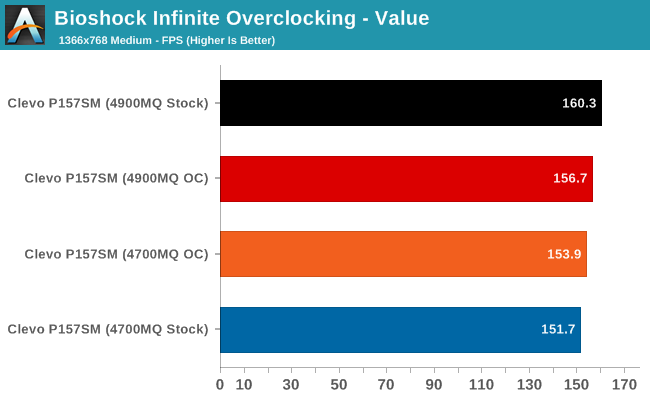
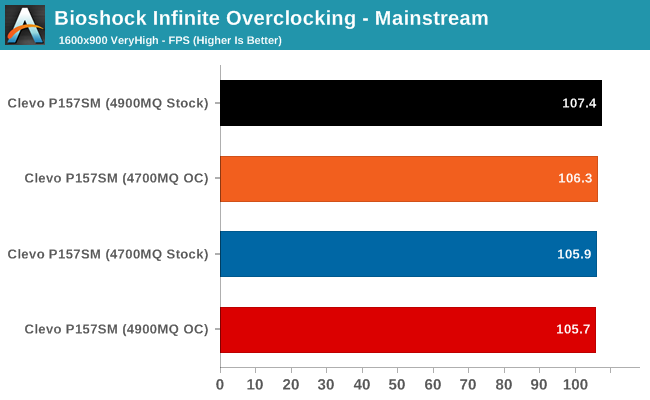
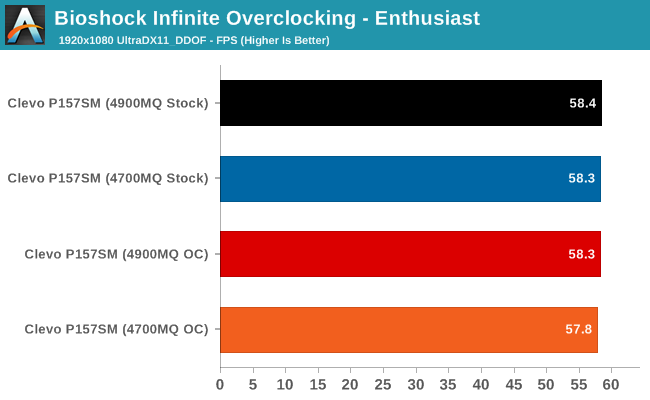
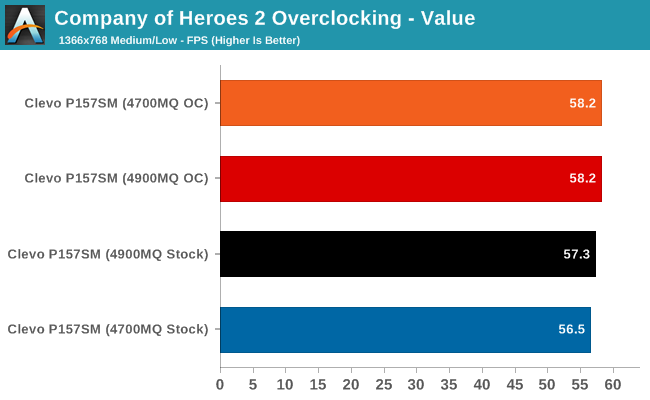
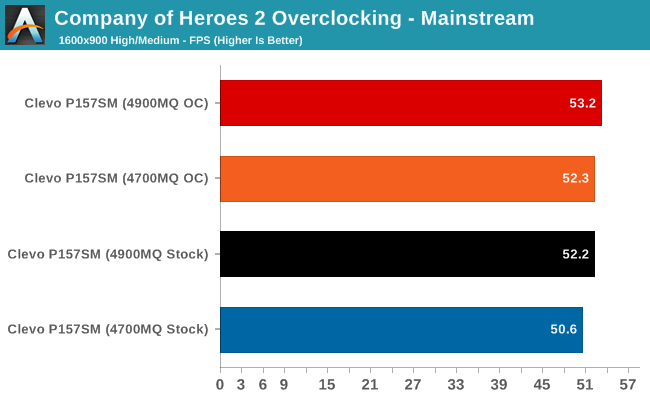
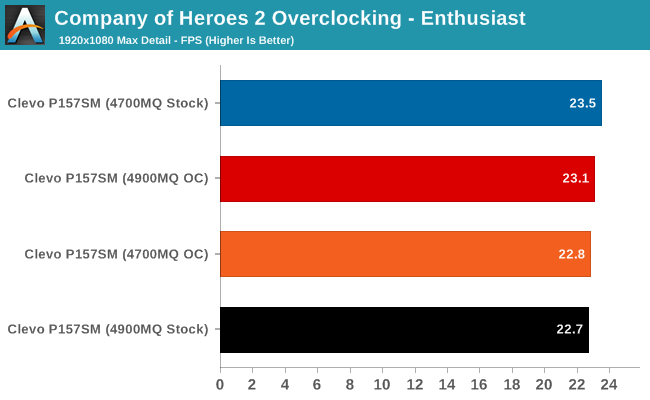
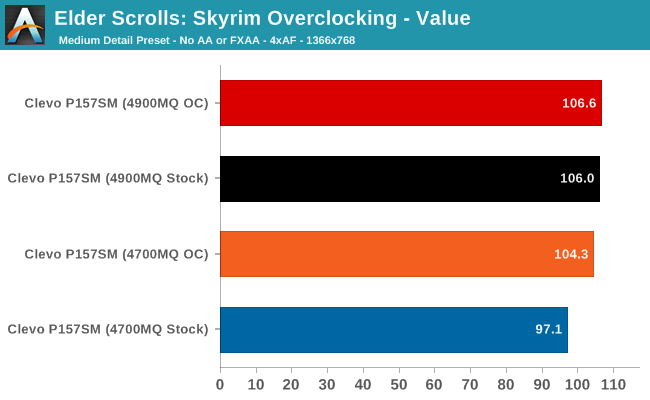
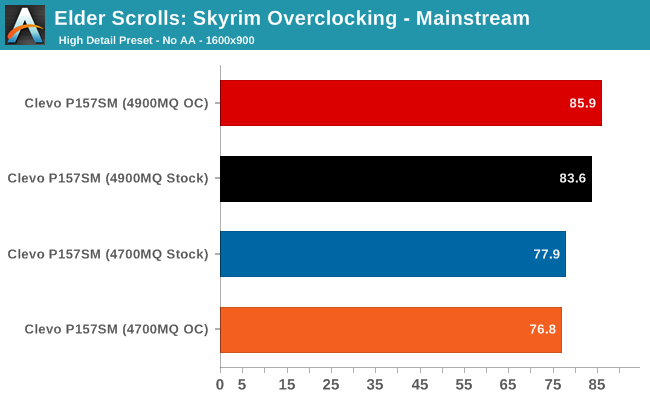
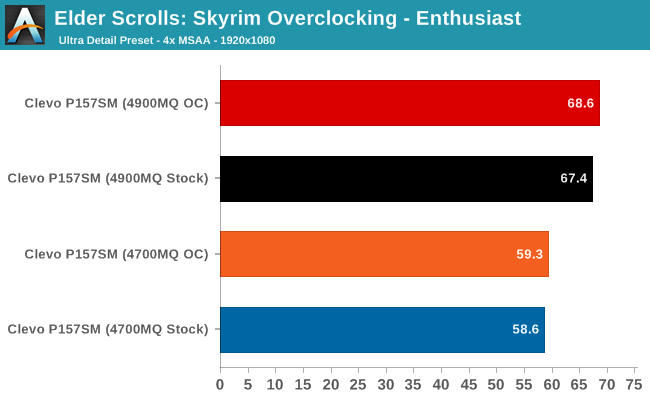
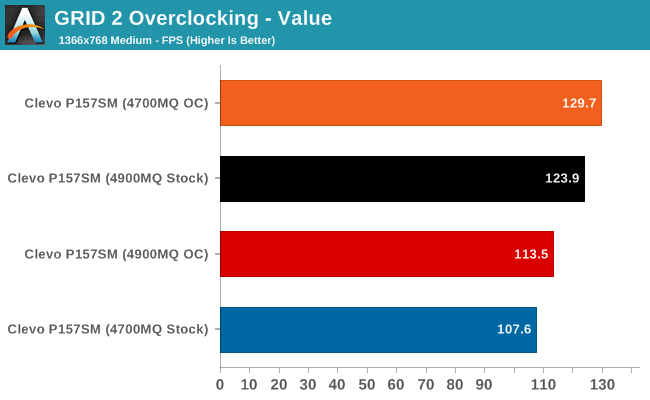
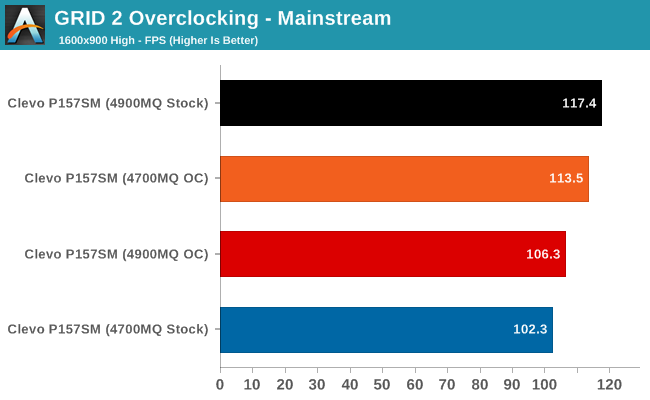

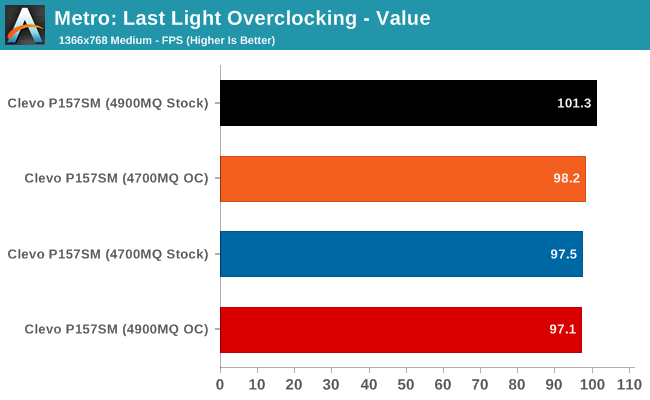
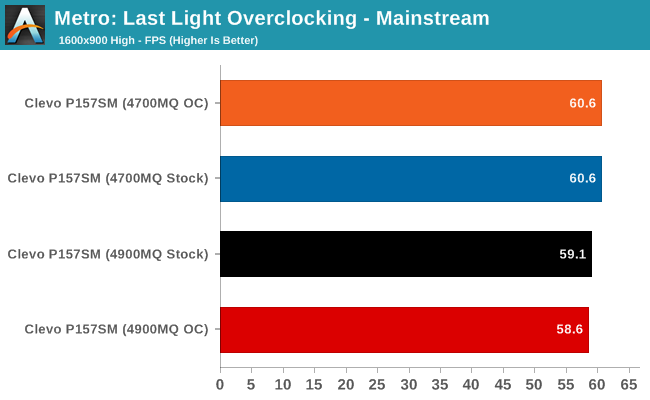
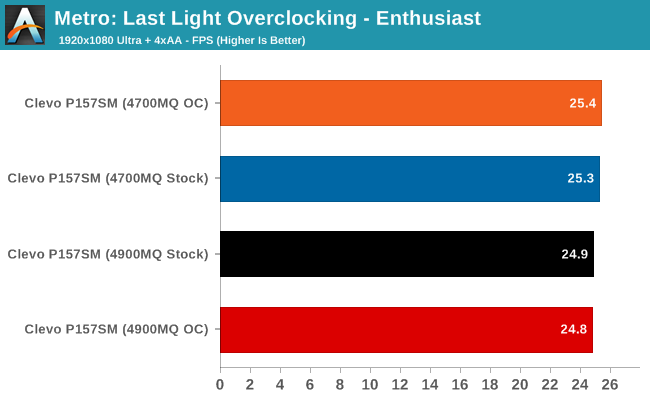
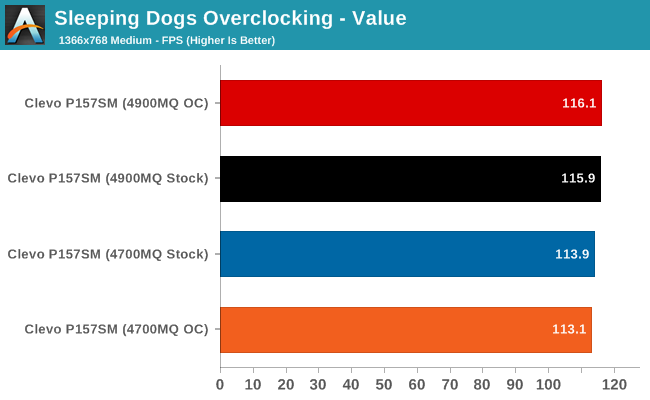
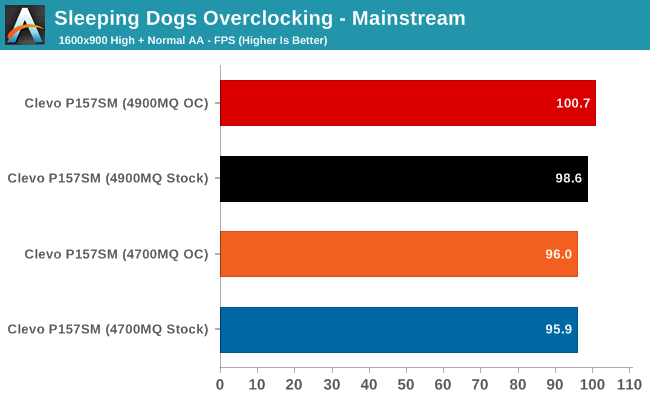
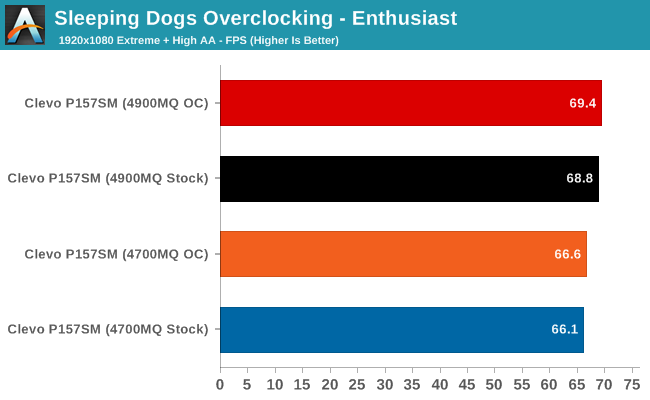

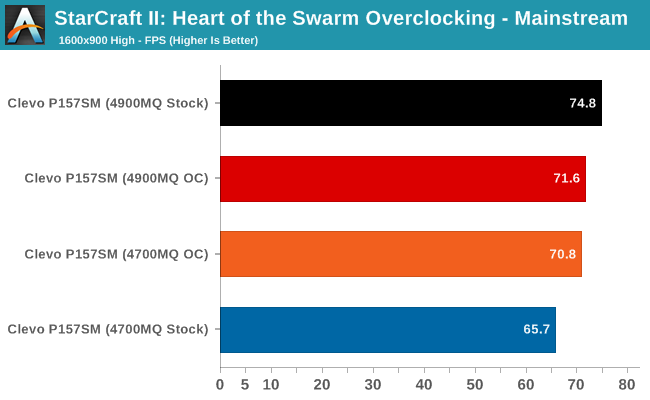
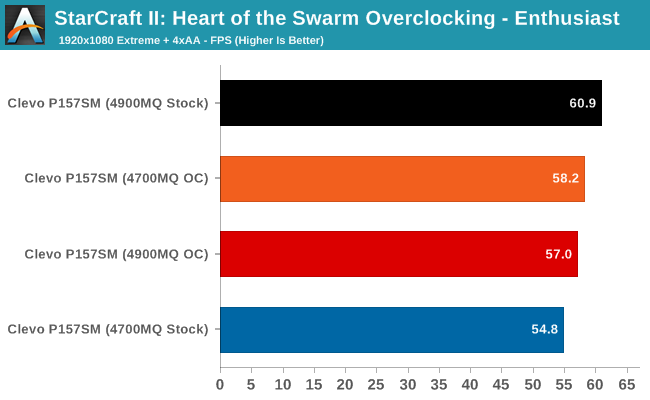
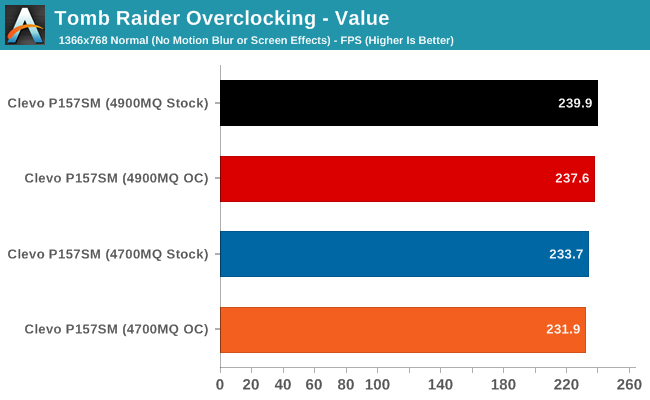
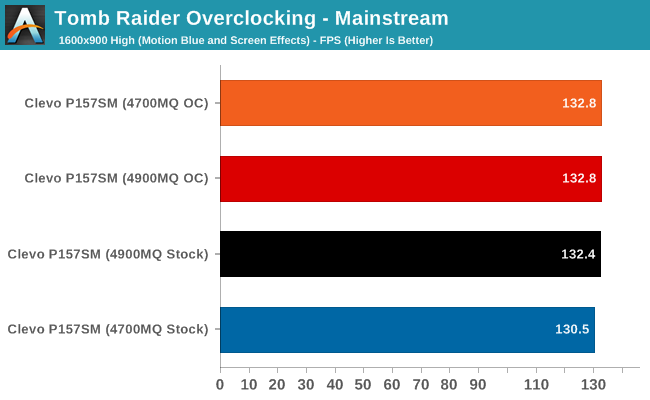

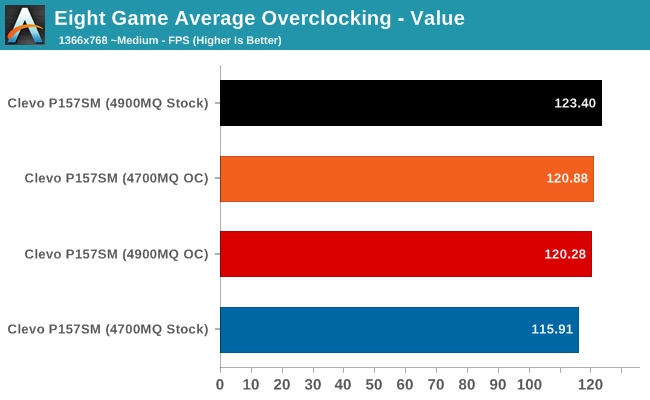
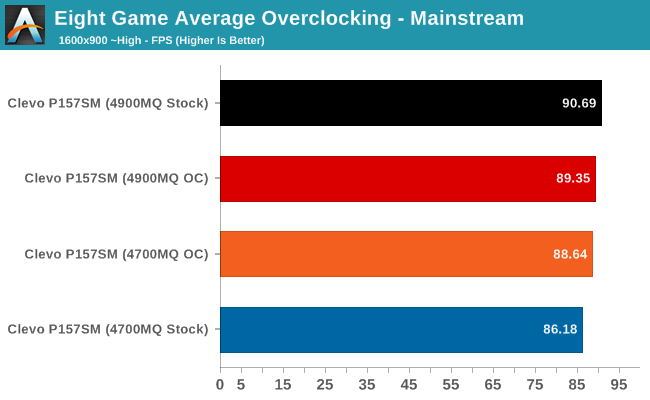
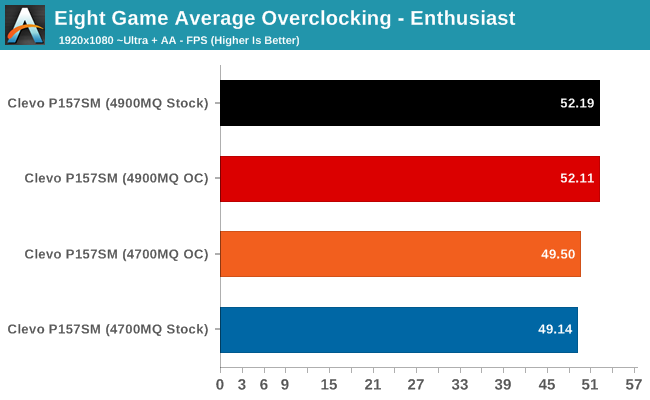
The same titles that benefit the most from the CPU upgrade should likewise benefit from overclocking. Skyrim, GRID 2, and StarCraft II apparently love having faster CPUs… but in practice, the gains from overclocking the CPU are small at best. The 4900MQ actually shows what I was talking about with the higher maximum clocks potentially ending up slower on average compared to the stock 4900MQ. In the end, the 4700MQ benefited more from overclocking than the 4900MQ, but perhaps with a bit more tuning I could coax the 4900MQ higher – like limiting the clocks to 4.0/3.9/3.8/3.7GHz for single/dual-triple/quad loads instead of setting them all to 4.0GHz. The short summary is that on average the stock 4900MQ is around 5-7% faster than the stock 4700MQ, while the overclocked 4900MQ is only 1-5% faster (and sometimes slower) than the overclocked 4700MQ.
Overall changes from overclocking the 4700MQ are anywhere from -3% to +8%, with larger changes at Value and Mainstream settings; the average change is +0.7% at Enthusiast, and +2% at Value and Mainstream. Overclocking of the 4900MQ shows changes ranging from -10% to +3%; GRID 2 and StarCraft II both drop in performance by more than 5%, so further tuning would be required to find a good balance. The 2-bin overclocking limit of the 4700MQ also prevents it from fully closing the gap with the stock 4900MQ, but it does get a bit closer.
There’s obviously a second question that I haven’t even touched on with regards to overclocking: can we get any additional performance out of the GTX 780M? Personally, with the GPU already hitting 85C under normal gaming use, I’m not inclined to push it harder. This is an expensive notebook with a very fast GPU, and until we get even higher resolution displays there’s really not much need to overclock the GPU. Others are welcome to do so, and I know some have already done so and posted results, but if I purchased a notebook like this I wouldn’t want to risk damaging a chip for a few more FPS.










47 Comments
View All Comments
Meaker10 - Friday, August 30, 2013 - link
It would be interesting to compare the XTU graph of each actually to see how their behaviour is different then. I might have to investigate that when I get the chance.That does not change the fact the 4930MX can run in the MSI at 4.1ghz during game play though. Sure that might not last during full rendering load or prime (stock CPUs will not either in any system including the sager) but it still behaves and just lowers the clock as it hits the power limit (Set to a healthy 75W) rather than temp throttle.
Notmyusualid - Sunday, September 1, 2013 - link
95C sounds about right to me.Speaking for my M18x R2 - If I'm gaming for extend periods (think h o u r s), I run HWinfo64 to force the CPU fan higher than the bios would ordinarily set, and I find 4 cores @ 4.4GHz in High Perf mode to be the most stable for me. 85C is the absolute max I would see in this state, and it is often less. I can run a 4.5GHz, and some run higher, but I'm happy with the stability with 4@ 4.4GHz.
The GPUs I don't overclock, ever.
xtyling - Friday, August 30, 2013 - link
Jarred.. On a $1500 budget and need for a portable (13-15inch form factor) gaming machine... which would you choose.. Digital Storm's Veloce or this Mythlogic Pollux?JarredWalton - Friday, August 30, 2013 - link
The Veloce is just the Clevo W230ST (sold as the Mythlogic Chaos 1313, as well as by most other Clevo resellers -- http://www.mythlogic.com/configure.php?id=147), and it's in a different category as it's smaller and tops out at the GTX 765M. You can get an idea of performance by looking at the Razer Blade 14 numbers, but of course for $1500 you wouldn't be getting GTX 780M in the first place. I believe the W230ST also includes an IPS panel (that's what Mythlogic says at least), so that's actually a nice bonus.For portability at the cost of performance, I think W230ST looks like a good compromise. Gaming at 1080p will need to drop down to ~High detail with no AA in many games, but I would be okay with that. If you can push the budget to $1630, grab one from Mythlogic with the 512GB mSATA SSD. :-)
name user - Friday, August 30, 2013 - link
ah yes, a tramp stampyes i will buy this product, with money, and take it places with me because its portable, with a tramp stamp
because im a goddamn idiot
gnorby - Friday, August 30, 2013 - link
While many Clevo based systems run about the same, dollar-wise, Mythlogic has a policy called the Phoenix Upgrade Policy which means that as long as you own the laptop, you pay 5% over their cost on any upgrade components, and they will install and then run a full test suite (just like when the machine is new) before returning it to you with the new hardware. That's as close to future-proofing as I've found yet.I have a Mythlogic Nyx 17", and since getting mine, my son and nephew both bought theirs. We've all been very pleased with pre-sales support, sales and technical support. These guys are a joy to work with.
Keep in mind that I'm 53, have dealt professionally with computers since the 1980s, and am not easy to impress.
DanNeely - Friday, August 30, 2013 - link
That sounds promising; but my question would be if the extremely high prices that a 3rd party would have to pay for the parts for a DIY an MXM are AMD/nVidia's (distributors?) prices or profiteering my the people putting them up on ebay/etc.I suppose the question to ask if I was in the market for one would be what their price would be to upgrade last years model from a 680 to a 780.
nerd1 - Friday, August 30, 2013 - link
I have found that upgrading MXM GPU is prohibitively expensive and usually it is way easier and cheaper to sell and repurchase a new laptop.rpgfool1 - Friday, August 30, 2013 - link
Any differences between the Clevo P170SM and the Clevo P177SM? I'm looking to get one probably around Black Friday or Christmas. Checking out the various Clevo resellers and vendors and Mythologic seems to be quite friendly, even though their prices are slightly higher. Also looked into PowerNotebooks, Malibal, XoticPC, and LPC-Digital.JarredWalton - Saturday, August 31, 2013 - link
The P170SM and P150SM have slightly different designs, with one less 2.5" drive supported I believe, plus no backlit (tramp stamp) on the touchpad, and the touchpad is Synaptics instead of Sentelic. Basically, all reasonable tradeoffs in my book.